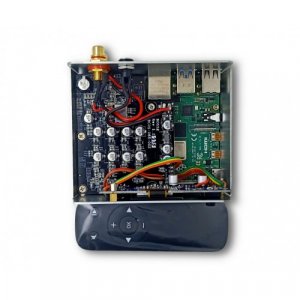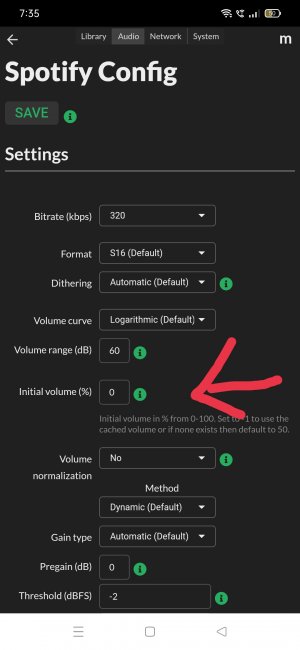You are using an out of date browser. It may not display this or other websites correctly.
You should upgrade or use an alternative browser.
You should upgrade or use an alternative browser.
ALLO BOSS 2 PLAYER
- Thread starter Sean de Silva
- Start date
For boss2 the minimum is Boss2 + acrylic case minus Raspberry PI. So you end up spending Rs 600 extra for the acrylic case.
Also the acrylic case will come with the brass standoff set (4 of them). You will require the standoff to firmly screw the board over the RPII
Last edited:
The picture makes it clear that this card cannot be fitted easily when using the rack. I have this gpio extender which I have used to mount hats externally. Whether this can be used to mount the boss 1.2 remains to be seen.Boss2 card is not small as like Boss 1.2 or any other HAT boards. It cannot sit completely on RPi, so it need a special case to hold, see the picture.
bobbyprajan
Active Member
Got my Allo Boss 2 Acrylic yesterday. Everything works properly. There are some settings like phase compensation, filter etc, are there some recommended settings for these ?
Sean de Silva
Well-Known Member
Got my Allo Boss 2 Acrylic yesterday. Everything works properly. There are some settings like phase compensation, filter etc, are there some recommended settings for these ?
Allo Boss2 - Filter Settings
Dear FMs, Yesterday I received my new Boss2 player with Moode OS. Very much pleased with the sound quality. I would like to know the filter settings which you recommend. 1) HV-EN - High Voltage Enable/Disable 2) FILTER – Filter selection A) PHCOMP – phase-compensation Enable/Disable B)...
bobbyprajan
Active Member
I am using hardware volume control, and Spotify connect sets the volume to 0db (100%) when it starts. The initial volume setting in the Spotify settings has no effect. Is there someway to set a sane volume level for the Spotify renderer !Allo Boss2 - Filter Settings
Dear FMs, Yesterday I received my new Boss2 player with Moode OS. Very much pleased with the sound quality. I would like to know the filter settings which you recommend. 1) HV-EN - High Voltage Enable/Disable 2) FILTER – Filter selection A) PHCOMP – phase-compensation Enable/Disable B)...www.hifivision.com
Sean de Silva
Well-Known Member
From my experience Spotify Connect always sets its volume to 0dB. When Spotify Connect connects to MoOde Spotify renderer, I manually drag the Spotify Connect slider to max level every playing session.I am using hardware volume control, and Spotify connect sets the volume to 0db (100%) when it starts. The initial volume setting in the Spotify settings has no effect. Is there someway to set a sane volume level for the Spotify renderer !
Here you go..From my experience Spotify Connect always sets its volume to 0dB. When Spotify Connect connects to MoOde Spotify renderer, I manually drag the Spotify Connect slider to max level every playing session.
Attachments
bobbyprajan
Active Member
I tried setting the "initial volume" but it seems to have no effectHere you go..
Sean de Silva
Well-Known Member
I
I have tried setting this to 100 but it doesn't work. The default stays at 0 and I have to manually increase on android spotify app as mentioned earlier which is not a big deal. Anyways I haven't used the Boss 2 player after the MoOde upgrade as another annoying issue had suddenly popped up and I haven't got down to troubleshooting yet.Here you go..
bobbyprajan
Active Member
My issue was due to alsa default volume set to 100%. Have set it to 30% nowNot sure why not working for you guys, I have set it to 100 and it's working as expected.
Edit - Just tried with different values and all worked well, tried this with Moode 7.6.1
I installed Moode again as I susupected some settings of my previous DAC remained. Some other niggles that i faced got solved
Last edited:
I was able to get hold of Boss2 Acrylic. It is pretty big and not easily rack-mountable. I have setup PiCorePlayer on it. In addition i have setup LMS on another server. I am able to control music from the android Squeezer app and Web client. However, i cant find any desktop linux client to control LMS playback. Can somebody give me any recommendation of a linux gui client?
I'm just about to try lms. Just downloaded it. It is totally written in perl and provides a web interface through port 9000. I too am looking for client as my primary machine which is always with me is my linux laptop or my macbook pro. These are the clients I have come across till nowI was able to get hold of Boss2 Acrylic. It is pretty big and not easily rack-mountable. I have setup PiCorePlayer on it. In addition i have setup LMS on another server. I am able to control music from the android Squeezer app and Web client. However, i cant find any desktop linux client to control LMS playback. Can somebody give me any recommendation of a linux gui client?
1. squeezeplay - https://sourceforge.net/projects/lmsclients/files/squeezeplay/
2. softsqueeze - https://wiki.slimdevices.com/index.php/SoftSqueeze.html
I will avoid softsqueeze becuase it is written in java.
My LMS server and desktop are on two different VLANs. Unfortunately, squeezeplay on the desktop is not able to see the LMS server. There is no way to specify the LMS ip address to squeezeplay. LMS broadcasts itself on port 3483 but even with udpbroadcastrelay it did not work out for me.
Softsqueeze does allow you specify the LMS ip address. However, this looks like full fledged play. What i am looking for a is a control point for LMS rather than a full blown player.
Softsqueeze does allow you specify the LMS ip address. However, this looks like full fledged play. What i am looking for a is a control point for LMS rather than a full blown player.
squeezeplay turned out to be a dissapointing experience for me. I ultimately removed it. Have installed squezelite 64bit on my raspberrypi and usbridge. Currently controlling all through the android squeezer app.My LMS server and desktop are on two different VLANs. Unfortunately, squeezeplay on the desktop is not able to see the LMS server. There is no way to specify the LMS ip address to squeezeplay. LMS broadcasts itself on port 3483 but even with udpbroadcastrelay it did not work out for me.
Softsqueeze does allow you specify the LMS ip address. However, this looks like full fledged play. What i am looking for a is a control point for LMS rather than a full blown player.
Few things were confusing. Figured it out.
1. The media servier is called LMS
2. The player is what plays to the soundcard / audio device. When you execute a player, it appears under 'player settings for ...' entry when you connect to LMS on port 9000. One can configure everything here instead of using the android squeezer app. If you have multiple devices on the same box, I couldn't find any setting to choose the audio device. So it looks like LMS will use only the default audio device
3. There are differently compiled player for the same OS platform. e.g. there is a version that plays only on pulseaudio device and not on ALSA and there is a version that plays only on ALSA but not on pulseaudio
I have still not figured out if there is any desktop player which shows you the song list, album art, etc with the stop, play, next, previous buttons to play music and also where to set the song rating.
Philos70
New Member
I've been using the Boss2 with a moode player for a while now. Since I watch movies through my computer I tried to find a way to stream the audio from a streaming source like netflix or amazon. All my equipment is connected through a hardwired switch - no wifi or bluetooth turned on. Can someone help me with this? How can I get Moode to recognize netflix, for example, and pick out the audio so I can play it through my audio components?
Moode recognizes my computer's internal hard drive, the SSD hard drive on which I store music, and a cd player.
I'm a wysiwyg guy who appreciates simplicity.
If this is not the place to ask this question please let know...
Thanks
Jeff...
Moode recognizes my computer's internal hard drive, the SSD hard drive on which I store music, and a cd player.
I'm a wysiwyg guy who appreciates simplicity.
If this is not the place to ask this question please let know...
Thanks
Jeff...
bobbyprajan
Active Member
What temps are the Rpi4 running when used with Boss 2 Acrylic ? Mine is at 60 degrees(ambient is 27-28), which I feel is a bit high.
Is there a possibility of using some heatsink with the Boss 2 Acrylic ?
Is there a possibility of using some heatsink with the Boss 2 Acrylic ?
so the allo boss 2 i have is connected over wifi and my home has a netgear orbi placed which covers well.the signal quality is around 77% at the device.The allo started malfunctioning only since last month.
I have moode r761 installed.downgraded from r8.0.2 because of airplay drop.
To troubleshoot i tried volumio.same kind of airplay drops.
anyone have any idea if the allo needs a wifi adapter or its a case of the rpi inbuilt network card gone bad?
If i want to buy network usb adapter what should i buy??
I have moode r761 installed.downgraded from r8.0.2 because of airplay drop.
To troubleshoot i tried volumio.same kind of airplay drops.
anyone have any idea if the allo needs a wifi adapter or its a case of the rpi inbuilt network card gone bad?
If i want to buy network usb adapter what should i buy??
Join WhatsApp Channel to get HiFiMART.com Offers & Deals delivered to your smartphone!
Similar threads
- Replies
- 17
- Views
- 4K
- Replies
- 33
- Views
- 18K
- Replies
- 159
- Views
- 24K
- Replies
- 3
- Views
- 16K



